 ,1, B Mishra
,1, B Mishra ,21Department of Mathematics, Indira Gandhi Mahavidyalaya, Ralegaon-445402,
,21Department of Mathematics, Indira Gandhi Mahavidyalaya, Ralegaon-445402, 2Department of Mathematics, Birla Institute of Technology and Science-Pilani, Hyderabad Campus, Hyderabad-500078,
First author contact:
Received:2020-07-12Revised:2020-11-14Accepted:2020-11-27Online:2021-01-15

Abstract
Keywords:
PDF (477KB)MetadataMetricsRelated articlesExportEndNote|Ris|BibtexFavorite
Cite this article
A Y Shaikh, B Mishra. Bouncing scenario of general relativistic hydrodynamics in extended gravity. Communications in Theoretical Physics, 2021, 73(2): 025401- doi:10.1088/1572-9494/abcfb2
1. Introduction
Observational confirmation on the accelerated expansion of the present Universe gave a new avenue of research in modern cosmology. The success of Supernova Ia [1, 2], Cosmic microwave background radiation [3, 4], weak lensing [5], large scale structure [6-8], WMAP data [9], Planck data [10] experiment groups made researchers think on the shortcomings of Einstein’s general relativity (GR). The component that is instrumental which for the accelerated expansion of the Universe is known as dark energy (DE). This component has occupied 68.3% of the energy budget of the Universe.A matter bouncing scenario has been discussed for the cosmic expansion of the Universe, as an alternative way to the inflationary paradigm [11]. It depicts that there is a transition phase of the contracting Universe towards the phase of expansion. Solomans et al [12] have investigated bounce behavior for anisotropic universes. Bamba et al [13] explored bounce cosmology from gravity and bi-gravity. Silva et al [14] have studied bouncing solutions in Rastall's theory with a barotropic fluid. Rip singularity scenario and bouncing Universe for Chaplygin gas as a DE model have been extensively discussed by Sadatian [15]. Astashenok [16] demonstrated the effectiveness of DE models in Teleparallel gravity.
Brevik and Timoshkin [17, 18] obtained bounce cosmology for dark fluid matter. Cai et al [19-22] have discussed the non-singular bouncing cosmology whereas Cai et al [23] have investigated the matter bounce cosmological models in extended gravity. The various astronomical aspects of the bouncing scenario have been discussed by Brandenberger et al [24]. Bamba et al [25-27] explored bouncing cosmological models by reconstructing the method in modified theories of gravity such as Gauss-Bonnet gravity and Teleparallel gravity. de la Cruz-Dombriz et al [28] have analyzed the bouncing model in the extended teleparallel gravity. Minas et al [29] investigated the bounce realization in the framework of generalized modified gravity. Tripathy et al [30] have shown the increase in the rate of dynamics with the increase in the parameter value of the bouncing scale factor. Tripathy and Mishra [31] have discussed bouncing cosmological models in the frame work of a simple extended theory of gravity.
The present work is devoted to the investigation of a bouncing scenario in the presence of general relativistic hydrodynamics (GRH) in the framework of an extended theory of gravity. An isotropic FRW Universe is considered in an extended theory of gravity. The organization of the paper is as follows: section
2. Basic set up and the field equations
With a matter-geometry coupling, the action for a geometrically modified extended theory of gravity can be expressed asIt can be noted that in gravitational collapse, GR and GRH have greater importance in the formation of black holes and neutron stars. The simulation of GRH problems is of great importance to the astrophysics community. An overview of relativistic hydrodynamics was written by Taub [32]. The equations of GRH and general magneto hydrodynamics and the corresponding methods of numerical solutions have been reviewed at length [33]. Also a comprehensive study of numerical hydrodynamics and magneto hydrodynamics in GR has been done [34]. Based on the entropy conservative form of GRH equations for a perfect fluid, Liptai and Price [35] presented a method for the general relativistic smoothed particle hydrodynamics. Kovtun [36] studied linearized stability in first order relativistic viscous hydrodynamics. Now, we have considered here the stress energy tensor as the perfect fluid which can be expressed as
It can be noted that ${T}_{\mu \nu }^{\mathrm{int}}$ vanishes when β limiting to null value. We consider the linear functional in the form $\tfrac{1}{2}f(T)=T$, so that 1+βfT(T)=1+2β and
We have considered the flat FRW metric in the form
In flat FRW space-time, Ananda and Bruni [37] have analyzed the bouncing scenario of the cosmological model. For both the closed and open FRW models, Singh et al [38] have presented the bouncing cosmological models. Now, the field equations (
3. Bouncing model
As singularity occurs during the expansion of the Universe, the inflationary scenario cannot provide a picture of the past history of the Universe. Therefore the matter bounce cosmology has been proposed, where the initial singularity can be avoided. In the initial phase of bouncing cosmology, matter dominates the Universe and then a bounce occurs without any singularity [39, 40]. In bouncing cosmology, the following are observed, (a) the scale factor decreases ($\dot{a}\lt 0$) in the contracting phase (negative time zone ), (b) the scale factor increases $\dot{a}\gt 0$ in the expanding phase (positive time zone), (c) at the matter bounce epoch (bouncing point), it yields $\dot{a}=0$. We have considered here a symmetric bounce, which can be described with the scale factor $a={{\rm{e}}}^{\gamma {t}^{2}}$, where γ is the positive constant parameter. It can be observed that the constant parameter γ has a major role in the cosmic expansion description. Further, the proposed scale factor does not experience any kind of singularities because the scale factor, the Hubble parameter and its derivatives are finite. Subsequently the Hubble parameter can be obtained as H=2γt.Figure 1 depicts the behavior of the bouncing scale factor as a function of cosmic time. It is seen that at the bouncing epoch t=0, the scale factor is symmetrical in nature. The value of parameter γ imparts the slope of the curves of the scale factor. From figure 1, it is observed that as the value of γ increases, so does the curvature of the plot. At t=0, the value of the scale factor is constant; however it does not vanish which enables the fact that there is a null value of the Hubble parameter at the bouncing epoch. For a specific realization of a bounce, with H<0, it represents a contracting Universe whereas in an expanding Universe, it yields H>0. Hence in continuation, it is concluded that at the bounce point, we must have H=0 and around it, we must have H>0. Figure 2 depicts the linear behavior of the Hubble parameter as a function of cosmic time. With regard to the bouncing model, the Hubble parameter evolves linearly from the contracting Universe towards the expanding Universe through H=0 at bounce.
Figure 1.
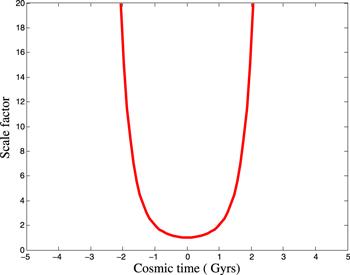 New window|Download| PPT slide
New window|Download| PPT slideFigure 1.Bouncing scale factor w.r.t. cosmic time.
Figure 2.
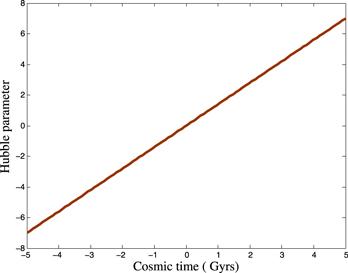 New window|Download| PPT slide
New window|Download| PPT slideFigure 2.Hubble parameter w.r.t. cosmic time.
The deceleration parameter can be derived as, $q\,=-1-\tfrac{\dot{H}}{{H}^{2}}=-1-\tfrac{1}{2\gamma {t}^{2}}$. The rate of expansion of the Universe is measured with the help of the cosmological parameter known as deceleration parameter. The deceleration parameter signifies inflation if q<0 whereas for the positive value i.e. q>0, it represents decelerated Universe. The Universe shows expansion with a constant rate, if the value of the deceleration parameter exhibits q=0. At t=0 i.e. at bouncing point, the deceleration parameter shows symmetrical behavior. From figure 3, it is observed that for both the contracting and expanding universes, the deceleration parameter q is negative, and after some finite time it tends to a constant value −1. In the contacting Universe, the deceleration parameter tends to the large negative values at the bouncing point even after evolving from q=−1. In the positive frame of the cosmic time, the deceleration parameter tends to q=−1 at late times. Thus in the derived GRH model, the value of the deceleration parameter resembles with the recent cosmological observations of Type Ia Supernovae and the Universe is accelerating throughout the evolution [41-43].
Figure 3.
 New window|Download| PPT slide
New window|Download| PPT slideFigure 3.Deceleration parameter w.r.t. cosmic time.
4. Physical parameters
Now, with the bouncing scale factor and some algebraic manipulation, we can obtain from equations (From equations (
To study the DE aspects of the model, three large class of scalar field DE models available in the literature such as the phantom ω<−1 [46], quintessence −1<ω≤0 [47] and the quintom ω cross −1. The quintom scenario can cross from phantom to quintessence region. As the EoS parameter is time dependent, The EoS parameter allows the model to transit from ω>−1 to ω<−1 [48]. Several observations suggest the limit for ω as (i) Supernovae cosmology project, $-{1.035}_{-0.059}^{+0.055}$ [49] (ii) WMAP+SN Ia, −1.084±0.063 [50], (iii) Planck collaboration, −1.03±0.03 [51].
The EoS parameter is graphically represented in figure 4, which is time dependent. For β→0 , the corresponding GRH model reproduces the results of general relativity i.e. ${\omega }_{\beta \to 0}\left(1+\tfrac{1}{3\gamma {t}^{2}}\right)$. From figure 4 , it is observed that, the EoS parameter shows symmetrical behavior about the bouncing time t=0. From figure 4, it is clear that EoS parameter crosses −1 in the interval (0.4,0.5) in the time zone of both the contracting and expanding universes. Therefore, this particular phenomenological model of Universe is quintom model [52]. In the neighborhood of bouncing point, the EoS parameter undergoes phase transition from ω>−1 to ω<−1. So the model presented here favors the quintom model. Also, after the bounce, the Universe enters into hot big bang age [53].
Figure 4.
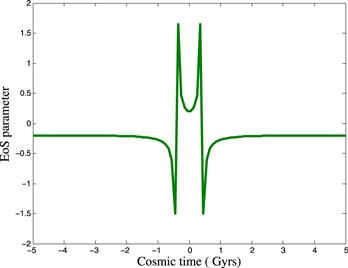 New window|Download| PPT slide
New window|Download| PPT slideFigure 4.EoS parameter w.r.t. cosmic time.
In the negative time zone (contracting Universe), the EoS parameter evolves in the matter dominated Universe at the bouncing point from a large positive values and approaches the Quintessence region. In the positive time zone (expanding Universe), it evolves in a matter dominated Universe at the bouncing point, converges to large negative values and approaches the Quintessence region at late times. The evolving of the EoS parameter is rapid near the bounce as compared to the far away time frame. The concerned raise in the rate of increment of the EoS parameter near the bounce depends on the value of the scale factor parameter γ as shown in the figure 4. Away from the bounce, the parameter γ does not have any significant impact on the EoS parameter. The recent Pantheon analysis that combines SNeIa data from several surveys, obtained in ωλ=−1.026±0.041 [54] and for a flat CDM model after combining with CMB constraints it becomes ωλ=−0.978±0.059. The constraints of EoS parameter coincide with the Planck collaboration [55] and WMAP [50] which give the ranges for EoS parameter as (i) −0.92<ω<−1.26 (Planck + WP + Union 2.1), (ii) −0.89<ω<−1.38 (Planck+ WP +BAO), and (iii) −0.983<ω<−1.162 (WMAP+ eCMB+ BAO+ H0). It can also be observed that the behavior of the model obtained, here, is in good agreement with the recent observational data.
Energy conditions are mathematically imposed boundary conditions in an attempt to claim the positive energy. Many energy conditions related to physical situation, the most common example is, the effect of DE that violates the strong energy condition (SEC). The energy conditions describe the properties common to all the states of matter and all non-gravitational fields. It rules out the unphysical solutions to Einstein’s field equations. Four types of energy conditions are (i) null energy condition (NEC), ρ+p≥0; (ii) SEC, ρ+3p≥0; (iii) Dominant energy condition, ρ≥∣p∣; and (iv) Weak energy condition (WEC), ρ≥0. At the bouncing point, it is observed that H=0 and $\dot{H}\gt 0$. Also from figure 5, it is observed that ρ+p<0 and ρ+3p<0. Hence in this particular bouncing model, NEC and SEC both are violated as shown in figure 5. NEC and SEC are in the negative domain near the bounce point in both expanding and contracting Universe. Hence, as the energy conditions are violating, the model evolves in the phantom phase with both at ω<−1 and ω>−1.
Figure 5.
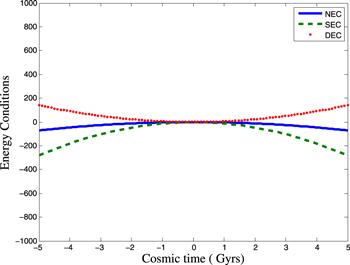 New window|Download| PPT slide
New window|Download| PPT slideFigure 5.Energy conditions w.r.t. cosmic time.
5. Stability factor
The stability of the model is studied in literature by using the ratio of sound speed given by ${C}_{s}^{2}=\tfrac{{\rm{d}}p}{{\rm{d}}\rho }$. If ${C}_{s}^{2}\gt 0$, then the model is stable and for ${C}_{s}^{2}\lt 0$, the model is unstable. The stability factor in the derived model is given bySince Γ>0,ε>0, equation (
The state finder diagnostic pair (r,s), where r is the jerk parameter and s characterizes the property of DE need to be assessed since they involve the third derivative of the scale factor [56]. The numeric value of this pair leads to certain situations such as (i) when (r,s)=(1,0), it leads to ΛCDM model (ii) When (r,s)=(1,1), it leads to CDM limit, (iii) when r<1, it is quintessence DE region, and (iv) when s>0 phantom DE regions. The pair can be obtained as
$r=\tfrac{\dddot{a}}{{{aH}}^{3}}=1+\tfrac{3}{2\gamma {t}^{2}}$ and$s=\tfrac{r-1}{3\left(q-\tfrac{1}{2}\right)}=-\tfrac{1}{1\,+\,3\gamma {t}^{2}}$.
The relation between the state finder parameters can be obtained as, $r=1-\tfrac{9s}{2(1+s)}$. Figure 6 depicts the plot of r versus s. It can be observed that the state finder curve passes through the point (1,0), which means that the derived GRH model behaves as ΛCDM model during the evolution of the Universe. The two domain in the plot (r<1,s>0) and (r>1,s<0) leads to quintessence region and Chaplygin gas region respectively. The value of the state finder pair in the present epoch is obtained as (1.011, −0.0024).
Figure 6.
 New window|Download| PPT slide
New window|Download| PPT slideFigure 6.r versus s.
In cosmology, the third derivative of the scale factor with respect to the cosmic time is termed the jerk parameter [57]. It is defined as $j(t)=1+\tfrac{3}{2\gamma {t}^{2}}$. The model close to ΛCDM are discussed with the help of jerk parameter in cosmology. The negative value of the deceleration and positive value of the jerk parameter are responsible for the phase transition from deceleration to acceleration. The jerk parameter for the ΛCDM model has a constant jerk. The jerk parameter is represented graphically in figure 7. The jerk parameter depends on the scale factor parameter γ. At the bouncing epoch, the jerk parameter has a singular value because of the vanishing nature of the Hubble rate at bounce. At a large cosmic time away from the bounce, the jerk parameter decreases to small values close to one, which was outlined in our earlier work [58, 59].
Figure 7.
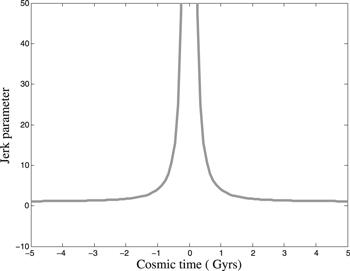 New window|Download| PPT slide
New window|Download| PPT slideFigure 7.Jerk parameter w.r.t. cosmic time.
6. Discussion, concluding remarks and scope for future research
We have presented a matter bounce scenario in the presence of GRH in the framework of extended gravity. We have considered the bouncing scale factor in order to study the matter bounce scenario which provides a symmetric behavior around the bounce. The scale factor shows the decreasing behavior and after the bounce it increases again with respect to the cosmic time. In the present bouncing scenario, it yields a→∞ and a→∞ as t→∞. It shows that the possibility of finite-time singularities do not occur in this model. In the flat FRW Universe, at the bouncing point energy density remains positive but SEC is violated. Also, as the Universe is accelerating after the bounce, it has ρ+3p<0. The Universe accelerates with the negative value of the deceleration parameter, which is consistent with the present day observational results. Since the EoS parameter of the matter undergoes a phase transition from −1 to +1 near the bouncing point, the presented GRH model in extended gravity is referred as a quintom model. It is worthy to mention here that as compared to [30], in this work it has been observed that there is a marginal change in the dynamical behavior of the model with the inclusion of GRH in the matter part. Moreover the stability analysis indicates the instability of the model. This might be due to the inclusion of GRH. However in this scenario, the Universe still enters into the hot big bang age after the bounce. The behavior near the bounce is least affected by the bouncing scale factor; however it is mostly decided by the coupling parameter induced in the action of the extended gravity. It is important to study the GRH cosmological models with some other form of bouncing scale factors such as, hyperbolic function and power function, to understand the role of GRH in the expanding Universe.Acknowledgments
BM acknowledges IUCAA, Pune, India for hospitality and support during an academic visit where a part of this work was accomplished. The authors are thankful to the anonymous referees for the valuable suggestions and comments for the improvement of the paper.Reference By original order
By published year
By cited within times
By Impact factor
DOI:10.1086/300499 [Cited within: 1]
DOI:10.1086/307221 [Cited within: 1]
DOI:10.1038/35010035 [Cited within: 1]
DOI:10.1086/317322 [Cited within: 1]
DOI:10.1103/PhysRevLett.90.221303 [Cited within: 1]
DOI:10.1103/PhysRevD.69.103501 [Cited within: 1]
DOI:10.1111/j.1365-2966.2005.09318.x
DOI:10.1038/nature04805 [Cited within: 1]
DOI:10.1086/513700 [Cited within: 1]
DOI:10.1051/0004-6361/201525830 [Cited within: 1]
DOI:10.1016/j.physrep.2008.04.006 [Cited within: 1]
DOI:10.1088/0264-9381/23/23/001 [Cited within: 1]
DOI:10.1088/1475-7516/2014/01/008 [Cited within: 1]
DOI:10.1134/S0202289313030109 [Cited within: 1]
DOI:10.1007/s10773-013-1855-1 [Cited within: 1]
DOI:10.1007/s10509-014-1846-6 [Cited within: 1]
DOI:10.1142/S0217732314500783 [Cited within: 1]
DOI:10.3390/universe1010024 [Cited within: 1]
DOI:10.1088/0264-9381/28/21/215011 [Cited within: 1]
DOI:10.1088/1475-7516/2012/08/020
DOI:10.1007/s11433-014-5512-3
DOI:10.1088/1475-7516/2015/03/006 [Cited within: 1]
DOI:10.3390/universe3010001 [Cited within: 1]
DOI:10.1007/s10701-016-0057-0 [Cited within: 1]
DOI:10.1016/j.physletb.2014.04.004 [Cited within: 1]
DOI:10.1088/1475-7516/2015/04/001
DOI:10.1103/PhysRevD.94.083513 [Cited within: 1]
DOI:10.1103/PhysRevD.97.104040 [Cited within: 1]
DOI:10.3390/universe5030074 [Cited within: 1]
DOI:10.1140/epjp/i2019-12879-3 [Cited within: 2]
[Cited within: 1]
DOI:10.1146/annurev.fl.10.010178.001505 [Cited within: 1]
DOI:10.1088/1742-6596/91/1/012002 [Cited within: 1]
DOI:10.12942/lrr-2008-7 [Cited within: 1]
DOI:10.1093/mnras/stz111 [Cited within: 1]
DOI:10.1007/JHEP10(2019)034 [Cited within: 1]
DOI:10.1103/PhysRevD.74.023523 [Cited within: 1]
DOI:10.1142/S0217751X18502135 [Cited within: 1]
DOI:10.1142/S0219887820500565 [Cited within: 1]
DOI:10.1016/S0370-2693(99)00469-4 [Cited within: 1]
DOI:10.1086/376865 [Cited within: 1]
DOI:10.1086/383612
DOI:10.1086/498491 [Cited within: 1]
DOI:10.1103/PhysRevD.78.084033 [Cited within: 1]
DOI:10.1103/PhysRevD.89.084043 [Cited within: 1]
DOI:10.1016/S0370-2693(02)02589-3 [Cited within: 1]
DOI:10.1103/PhysRevD.59.123504 [Cited within: 1]
DOI:10.1103/PhysRevD.74.083520 [Cited within: 1]
DOI:10.1088/0004-637X/716/1/712 [Cited within: 1]
DOI:10.1088/0067-0049/208/2/19 [Cited within: 2]
DOI:10.1051/0004-6361/201833910 [Cited within: 1]
DOI:10.1016/j.physletb.2004.12.071 [Cited within: 1]
DOI:10.1088/1126-6708/2007/10/071 [Cited within: 1]
DOI:10.3847/1538-4357/aab9bb [Cited within: 1]
DOI:10.1051/0004-6361/201321591 [Cited within: 1]
[Cited within: 1]
DOI:10.1143/PTP.100.1077 [Cited within: 1]
DOI:10.1007/s12036-019-9591-4 [Cited within: 1]
DOI:10.1016/j.newast.2020.101420 [Cited within: 1]
